Get Started with Conversation Design Strategies
Learning Objectives
After completing this unit, you’ll be able to:
- Define conversational style.
- Explain how variation in language is important to inclusive conversations.
- Identify the difference between topic and action in conversation design.
The Age of Chatbots
People spend more time online now than ever before. One result of all of the digital-first experiences and transactions we’re having is that we need more support from the businesses we’re interacting with.
Chatbots are a prime example of how brands talk with customers in a digital-first society. Whether voice- or text-driven, chatbots can be a great way to efficiently communicate with lots of customers on a regular basis. Even if chatbots can’t resolve every customer issue all of the time, they can speed up the process by triaging support requests. A well-designed chatbot might direct as many customers as possible toward FAQs, self-help knowledge pages, and other automated resolutions in order to shorten the queues of folks waiting for a live service agent.
This unit is a look at some strategies for designing great conversations. We walk through our Top 5 Greatest Hits for conversation design, and you can try your hand at a few exercises to bring the strategies to life. But first, an important note about style—conversational style.
What Is Conversational Style?
Conversational style is how we talk. Everything we say comes out in some kind of way, and that way is your style. Your style might be more formal, my style could be more casual, and somebody else’s style might be heavily steeped in the local vernacular and response times common to where they grew up.
As a conversation designer, one of your most important tasks is to design bots that are easily used by many users, whatever their conversational styles.
In other words, be inclusive!
If you design a bot to only accommodate your style, you risk alienating everyone who has a different style. That’s being exclusive, not inclusive. Fortunately, linguistics can help us check our biases, and be strategic in designing inclusive, natural feeling conversations.
Top 5 Greatest Hits for Conversation Design
First things first. What is linguistics? Linguistics isn’t learning to speak many languages (although that’s never a bad thing to do!)—it’s the scientific study of language and its structure. A linguist, then, is a language scientist.
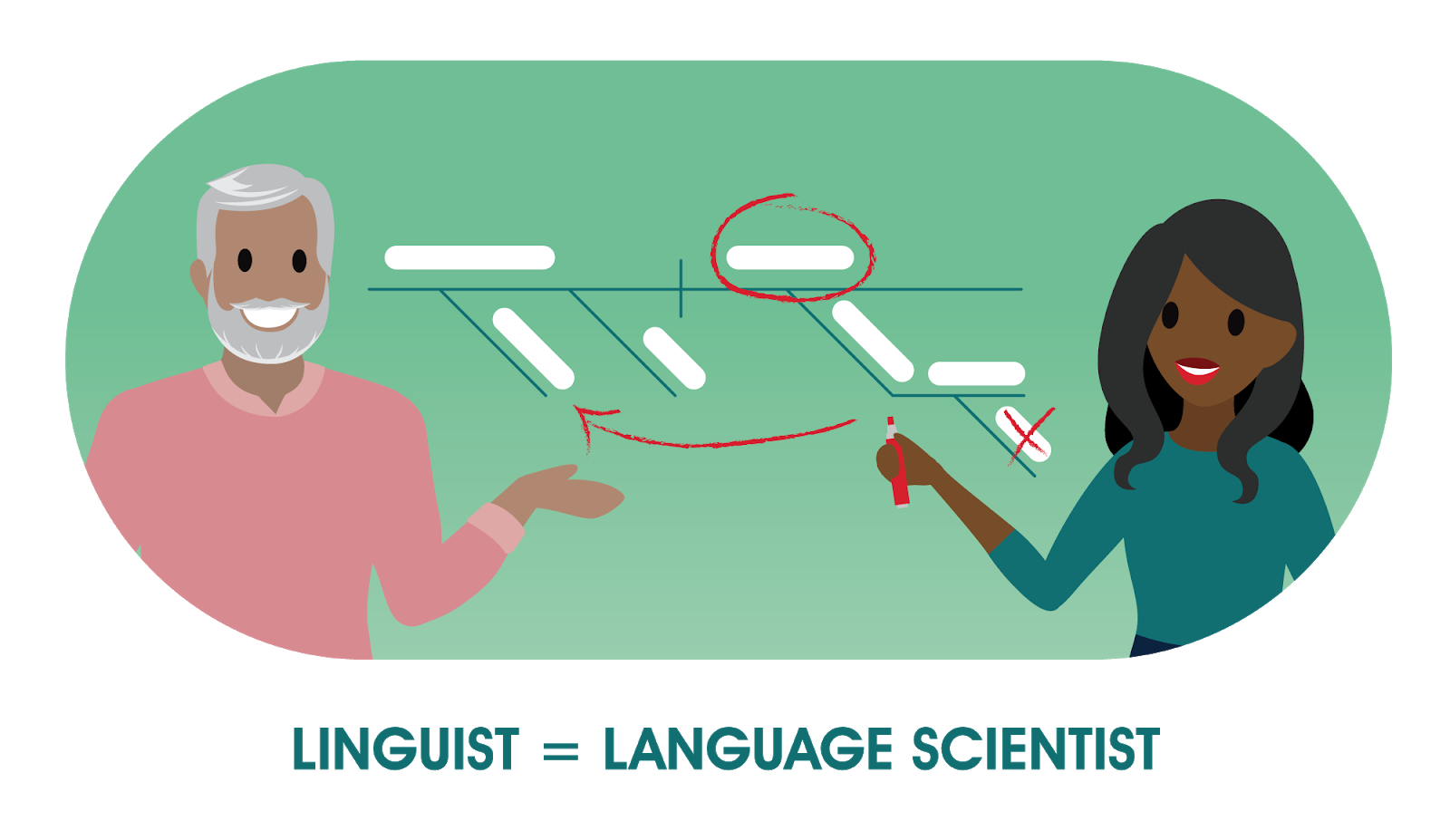
Linguistics is the science of how language works, and it tells us how to design a conversation that feels natural. You can spend a lifetime studying linguistics, but for our purposes, let’s start with the Top 5 Greatest Hits—the keys to designing great conversations.

1. Be descriptive. Be descriptive, not prescriptive, when designing conversations. Descriptive means looking at what your users are saying and trying to understand and make meaning from it. Prescriptive means judging how your users are speaking and telling them how you think they should be talking.
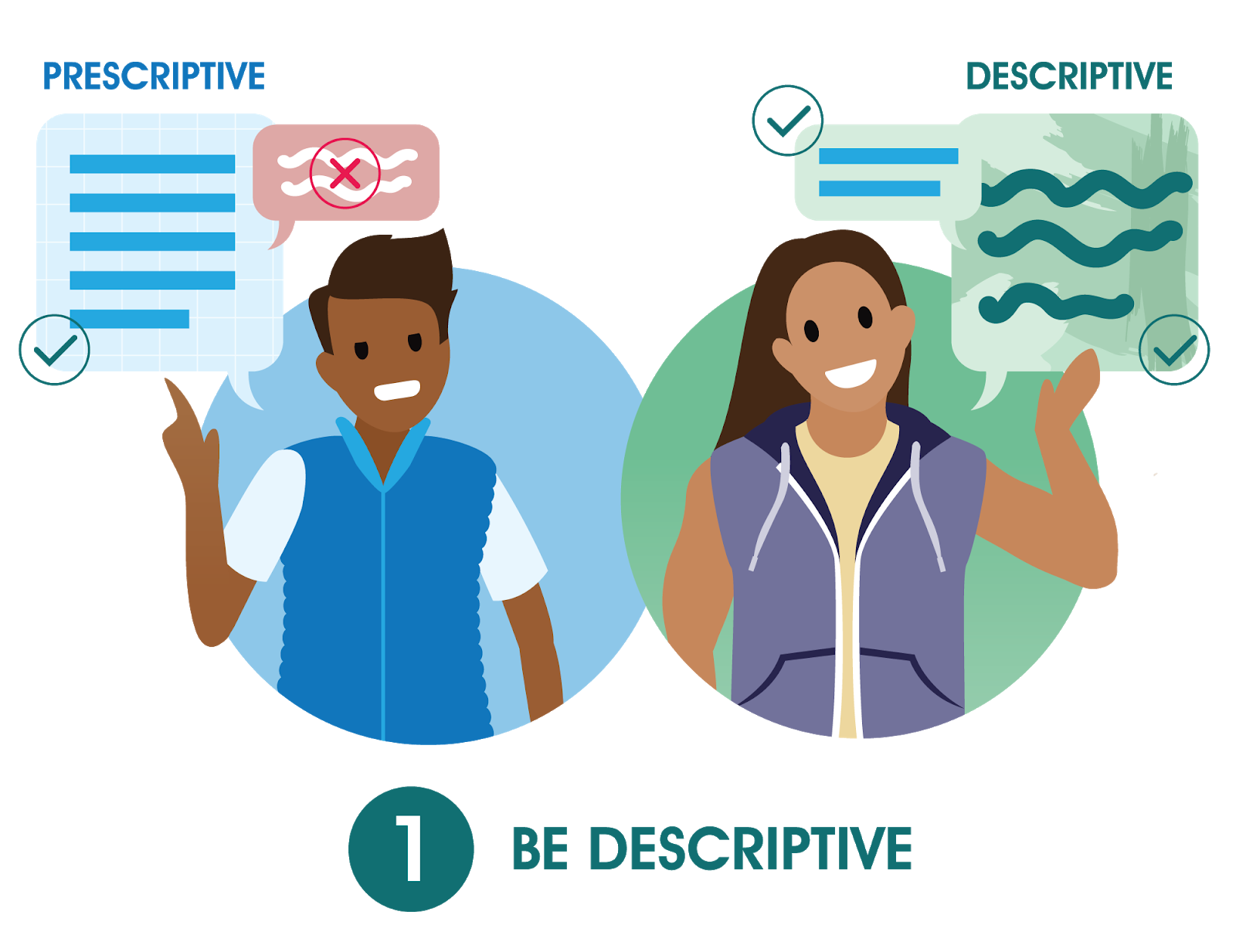
When you design around preconceived notions about how language “should” work, you run the risk of alienating users. That creates usability issues at best and an equity issue at worst, especially when users represent their social identity through their language (and they do… we all do). Embrace variation in language, and you’re opening your arms to welcome more people to the conversation. That’s being inclusive. In business terms, that means more potential customers.
Remember, language is a practice. New words—and ways of spelling old ones—are entering our vernacular all the time. The way we communicate and the languages we use are living, dynamic systems that are always changing!
Give it a try. Match the words/phrases that have a similar meaning but are of different vernaculars.
The knowledge check below isn’t scored—it’s just an easy way to quiz yourself. To get started, drag the function in the left column to the matching category on the right. When you finish matching all the items, click Submit to check your work. If you’d like to start over, click Reset.
2. Be purposefully marked. Linguistic analysis is founded on a key principle: markedness. In linguistics, we say that something is “marked” when it deviates or stands out from the more common form.
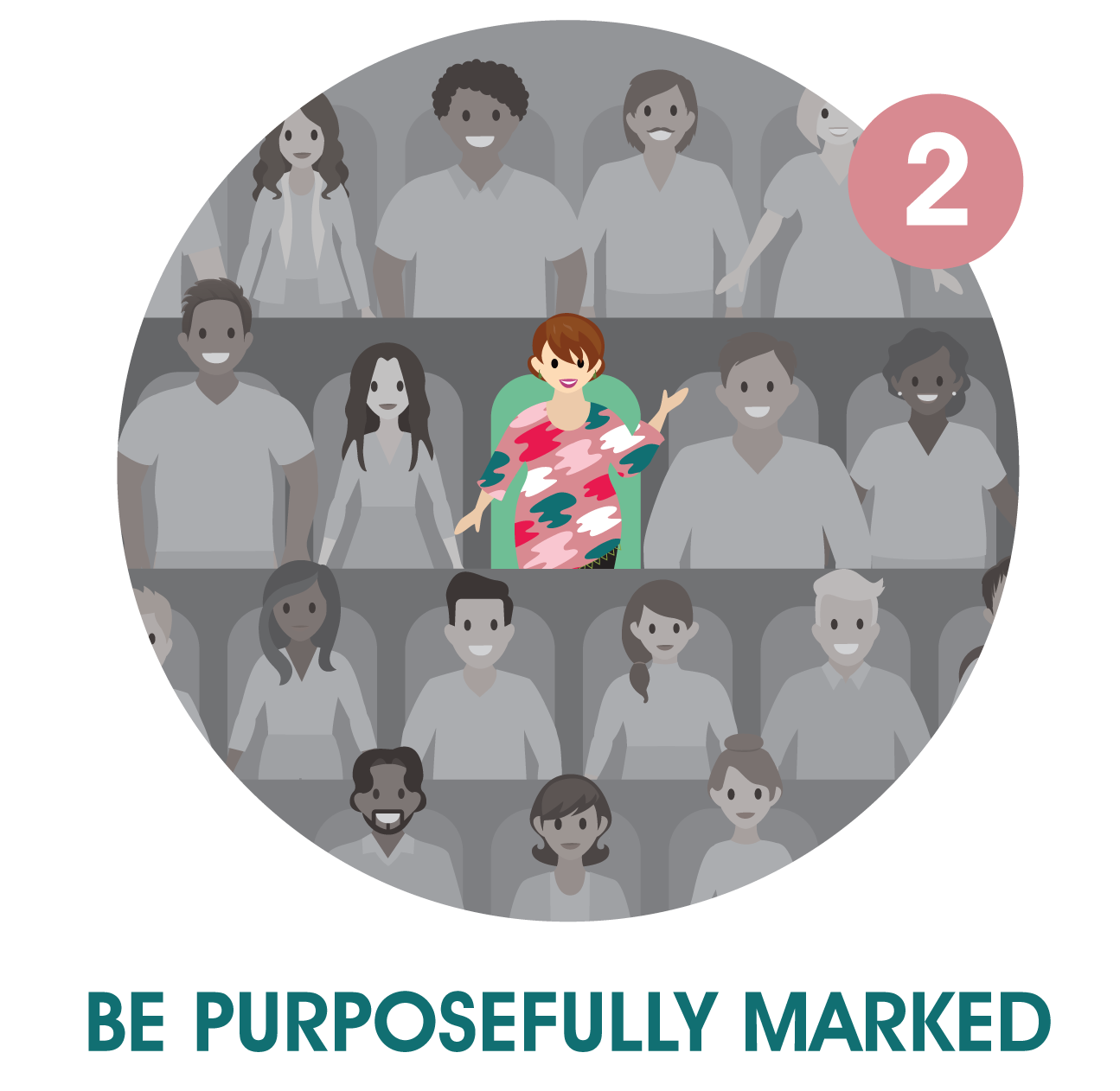
In this illustration, greyscale people sitting in grey chairs are more common, so they’re considered unmarked. The colored-in person in the green chair stands out, so they’re considered marked. When something is marked, it can signify a different or additional meaning. In this case, does the green chair indicate a different type of ticket? VIP status? It causes the user to do additional interpretation.
When it comes to conversation design, let’s think about texting and punctuation. Do you notice when the person you’re texting with uses a period in their message? Particularly when they don’t usually use a period in their other messages? That means that using a period is marked and means something different or extra. Many groups of users, for instance, perceive a period in text to mean distance or anger.
You can use purposeful marks to express different things in your conversations. Going back to the previous graphic, if you use a period at the end of every sentence in your bot, your “green chair” will come when you instead use an exclamation mark as a marker.
Here’s an example from Salesforce’s Einstein Bot Template.
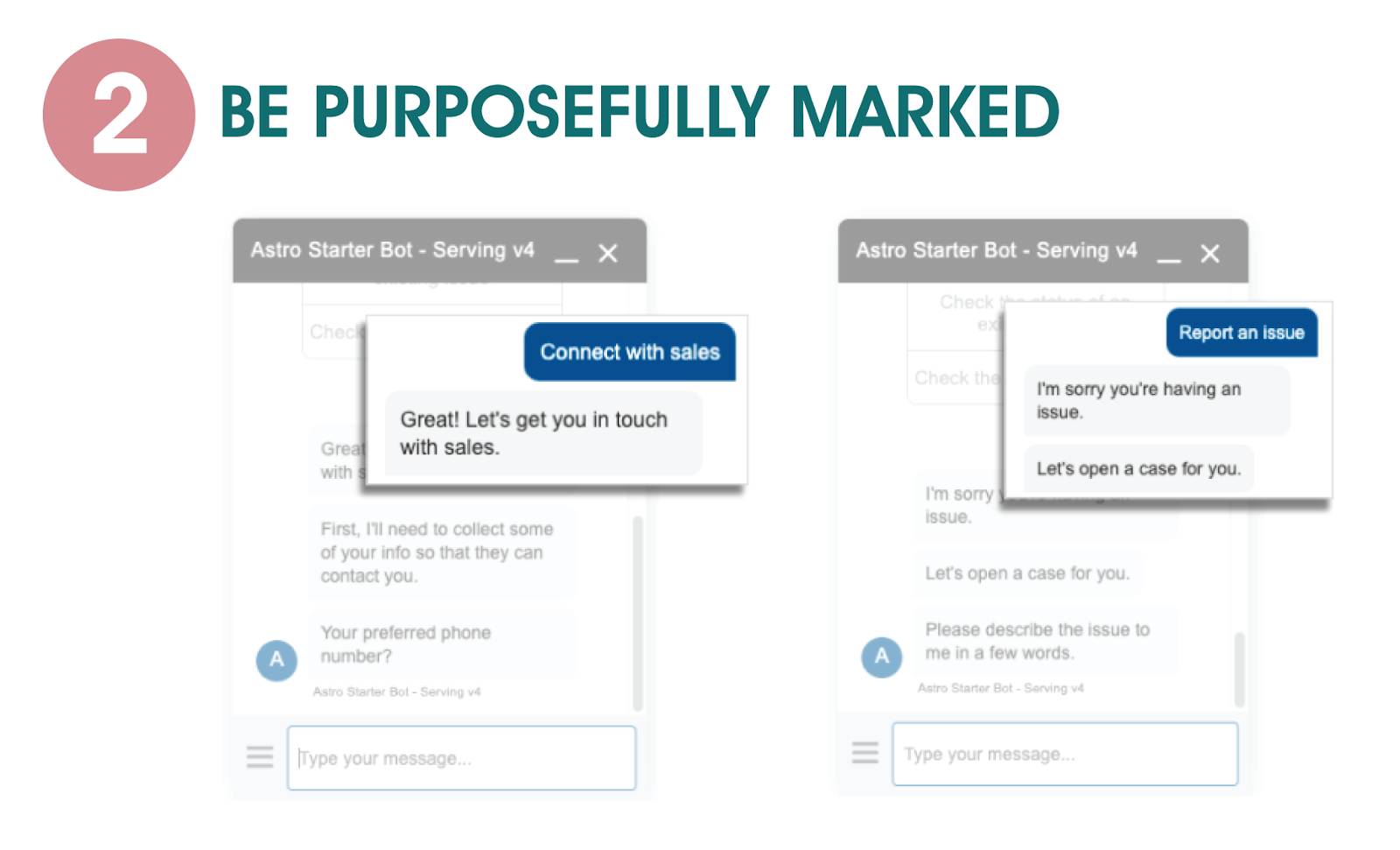
Here, we made period usage unmarked because we wanted to adhere to a more formal conversational style. We use things like exclamation points sparingly, but strategically. When the user wants to connect with sales, we want to celebrate their interest, so we use “great!” with an exclamation point. But when the user wants to report an issue, that isn’t a positive, so we express condolences with, “I’m sorry you’re having an issue” and stick to the period mark.
Decide on your common, unmarked format and stick to it. Deviate from it with purpose.
3. Start with a verb. Imagine you’re taking a class to learn a second language. The teacher isn’t going to just teach you how to talk about yogurt. They’re going to teach you how to talk in order to do things involving yogurt, whether you want to get some to eat, or explain why you avoid it at all costs. Your teacher explains to you how to convey actions with your words in relation to a topic.
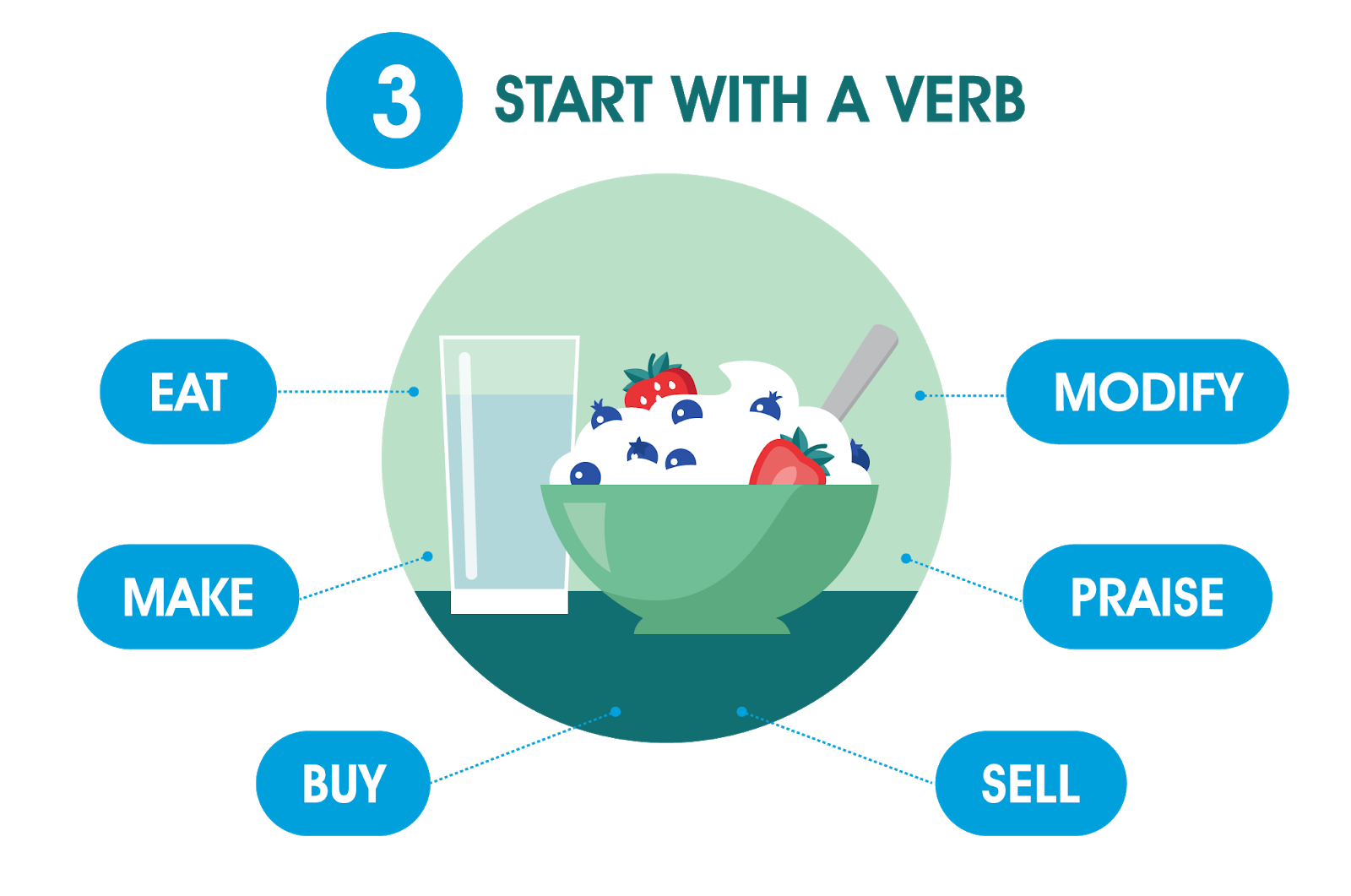
When designing conversations, the topic is only half of the equation. We need topics to provide a great foundation for designing conversation, but conversation is also about action.
Every participant in conversation, regardless of the topic, is actively doing something with what they say. When someone’s chatting with a chatbot, they’re trying to get an answer to a question, resolve a problem with a product or service, and so on. In everyday conversation between people, the participants are also doing things through talking—explaining a point of view, clarifying another person’s logic, or maybe making plans. Without considering what the user is trying to do, we won’t ever actually be able to complete transactions at scale for them.
Actions are fundamentally about verbs. They’re what you do! The best way to help users understand what they can do in conversation with a chatbot is by labeling your intents and dialogs so that they start with a verb. Let’s give it a try.
Match the following verbs with nouns to create actionable intents.
The knowledge check below isn’t scored—it’s just an easy way to quiz yourself. To get started, drag the function in the left column to the matching category on the right. When you finish matching all the items, click Submit to check your work. If you’d like to start over, click Reset.
4. Use discourse markers. Discourse markers are words or phrases that help structure the flow of a conversation. These markers may seem like “filler” words, but they function as signals of understanding or connection in discourse.
Confused? Don’t worry! Some examples will make it clear.
|
Discourse Marker |
Function |
Example |
|
oh |
Signify receipt/realization of info |
“Oh, you want to cancel?” |
|
so |
Show the result of a prior action |
“So, you want to cancel?” |
|
well |
Diverge from the options provided in a previous question |
“Well, I’d actually prefer to reschedule.” |
|
like |
Can indicate that “this is what I want you to focus on” |
“I already tried to change it like, three times.” |
Reading the examples aloud might crystalize it for you. That’s why we use them a bit more sparingly in text chats than voice conversations—discourse markers work best when spoken aloud. But you can use them in chatbot conversation design. Just be extra precise.
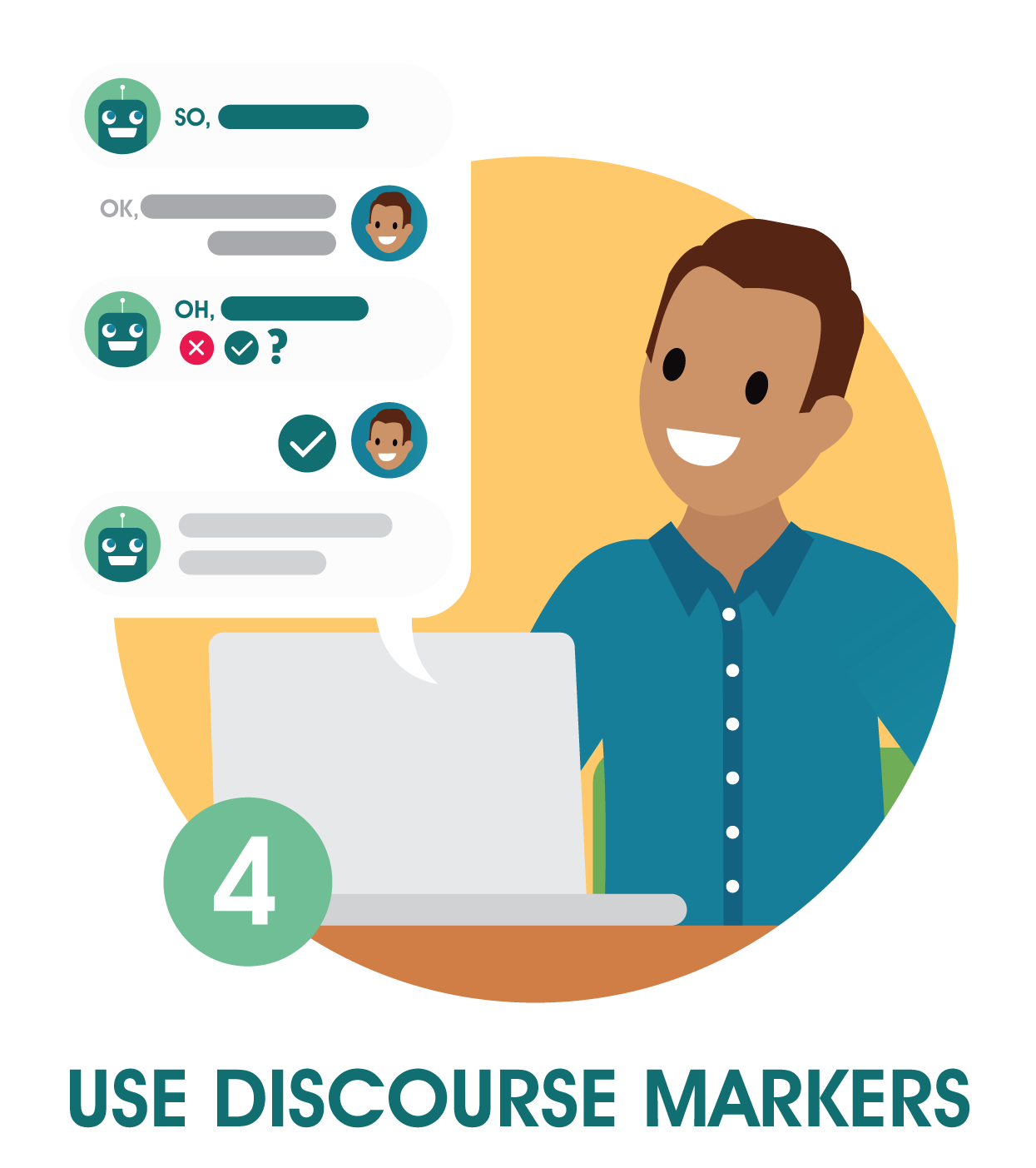
Fill in the missing discourse markers in the example dialogue below.
Ready to review what you’ve learned? The knowledge check below isn’t scored—it’s just an easy way to quiz yourself. To get started, select your answers from the drop-down . When you finish selecting your answers, click Submit to check your work. If you’d like to start over, click Restart.
5. Decide on a conversational style (and stick to it!). Last but certainly not least, a guiding principle for designing any conversation: Pick a conversational style and stick to it. Your style isn’t expressed only by the words you program your chatbot to use. Things like intensifiers, exclamation points, and even setting the bot response delay all inform your conversational style.
More intensifiers, emojis, and exclamation points + Short response delay = High involvement style.
Less intensifiers, emojis, and exclamation points + Longer response delay = High considerateness style.
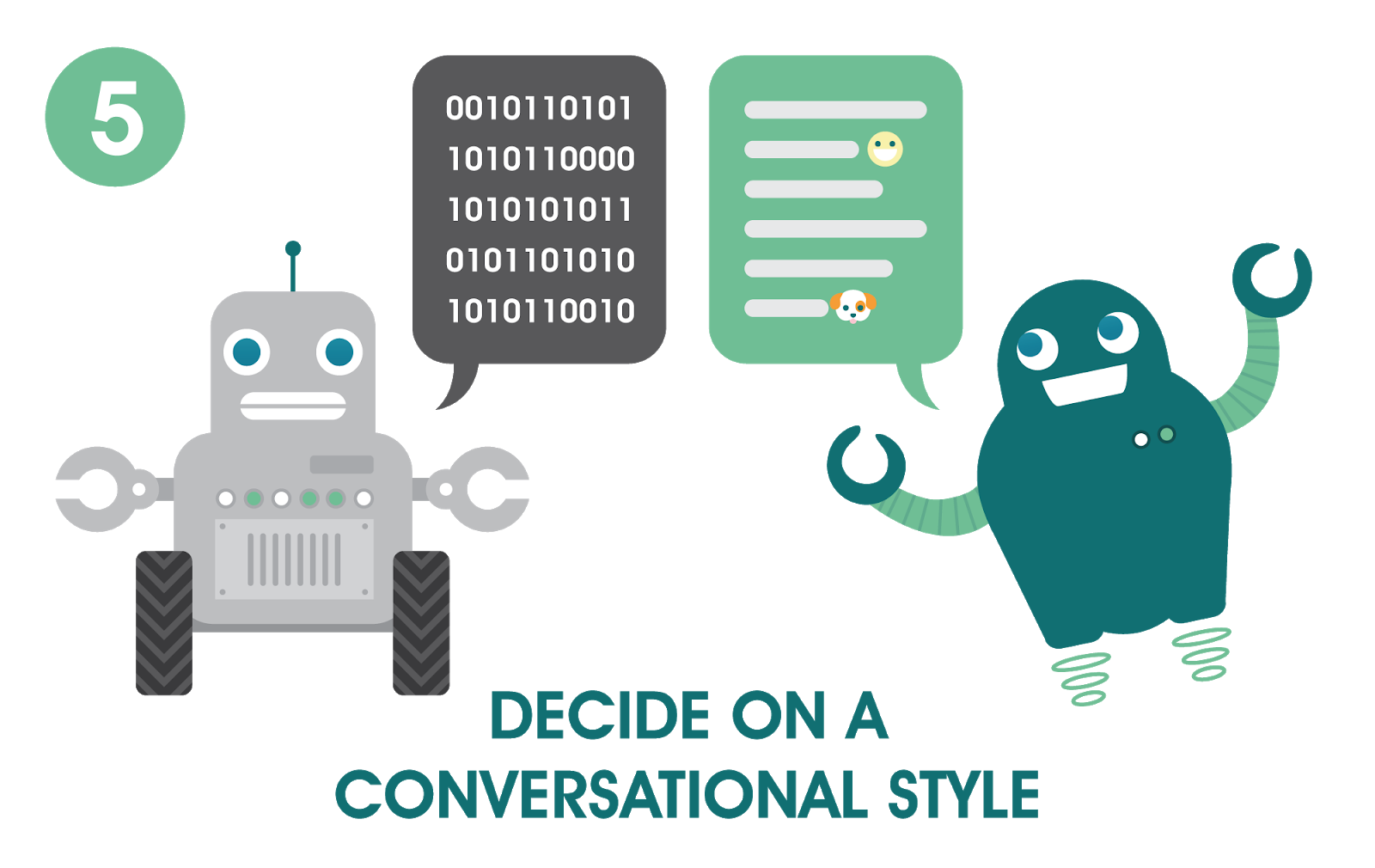
People in different parts of the world often use different conversational styles. For instance, overlapping speech is not considered an interruption in some communities in New York, while the style in some communities in California prefers to hear only one person speaking at a time. Tweaking your bot’s response delay can result in a style that leans more toward considerateness or involvement—it’s all down to the style that best serves your users and your purpose!
Drag and drop each phrase into the appropriate bucket based on how it conveys conversational style.
The knowledge check below isn’t scored—it’s just an easy way to quiz yourself. To get started, drag the function in the left column to the matching category on the right. When you finish matching all the items, click Submit to check your work. If you’d like to start over, click Reset.
Designing a great conversation is, in many ways, just like designing any other user experience. You need a vision, the right team of stakeholders and partners to execute on it, and a solid project plan to guide you through creating the right conversations for your business needs.
The Top 5 Linguistic Greatest Hits we covered here can inform your process at a high level. But your biggest takeaway from this introduction to conversation design should be even simpler than a five item list: Be inclusive. Embrace the different ways people talk (and type), and design conversations that accommodate all of them as best you can. Every conversation is an opportunity for relationship building, whether to win a new customer or strengthen the bonds with a longtime fan of your brand.
